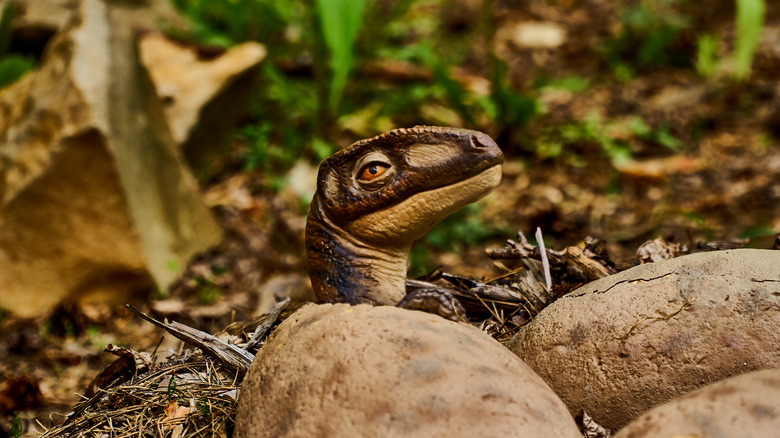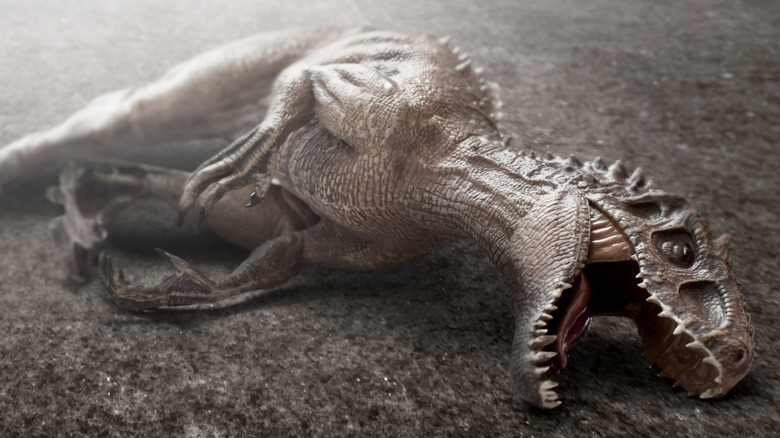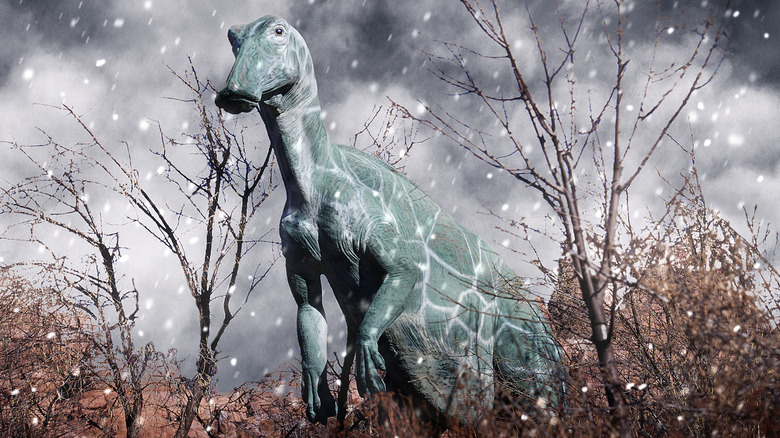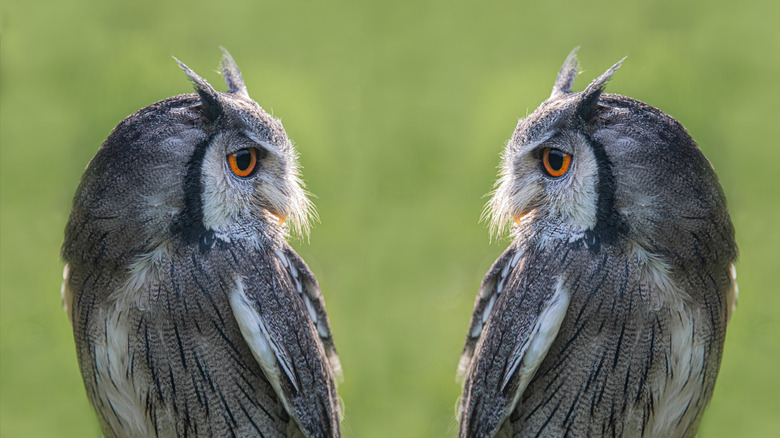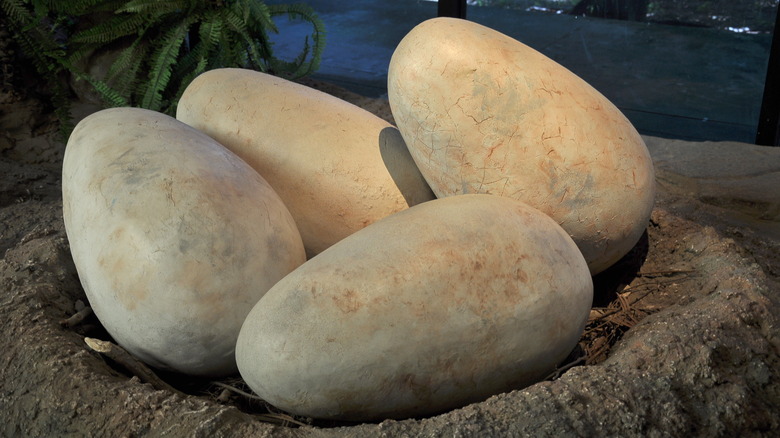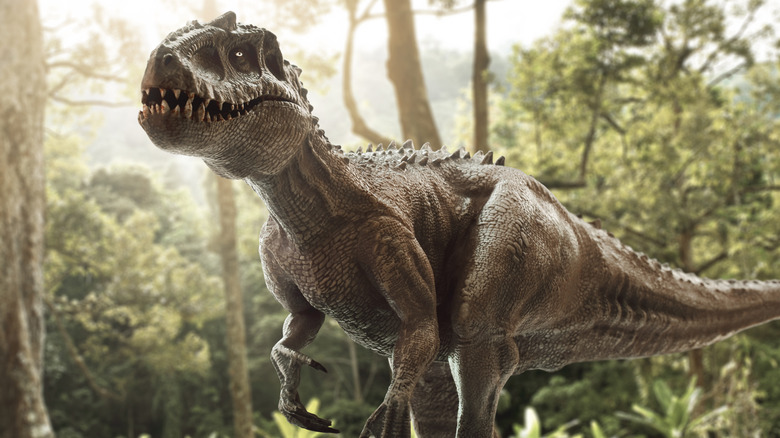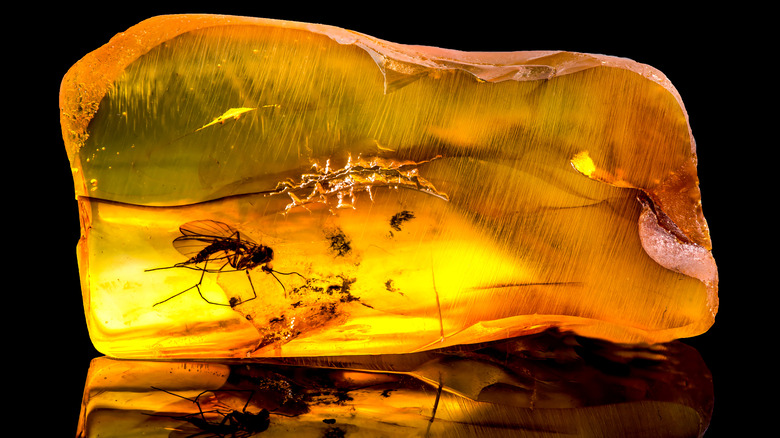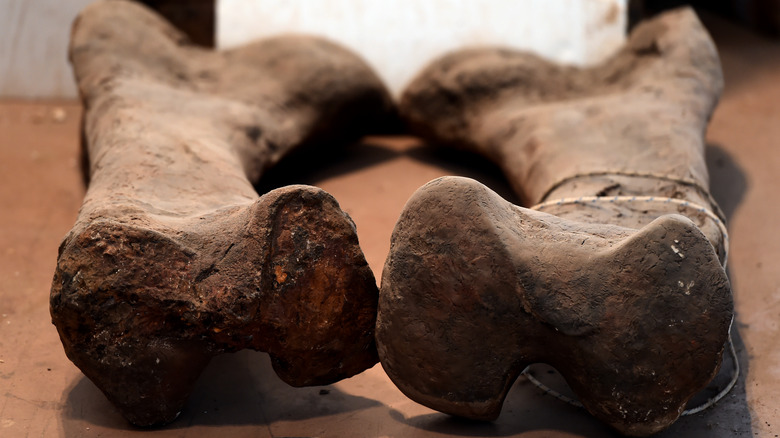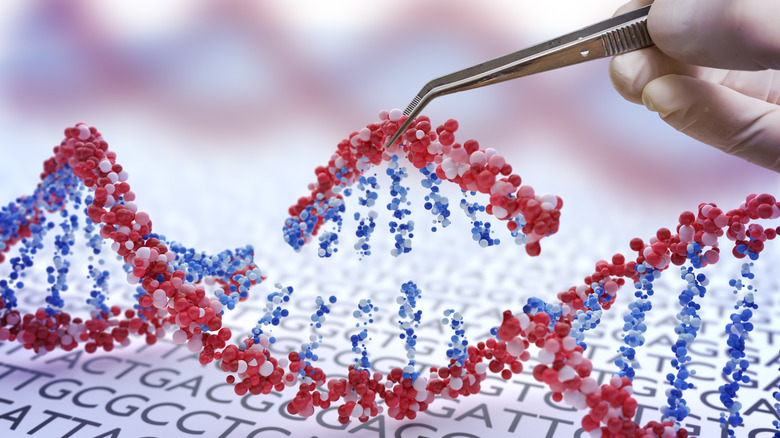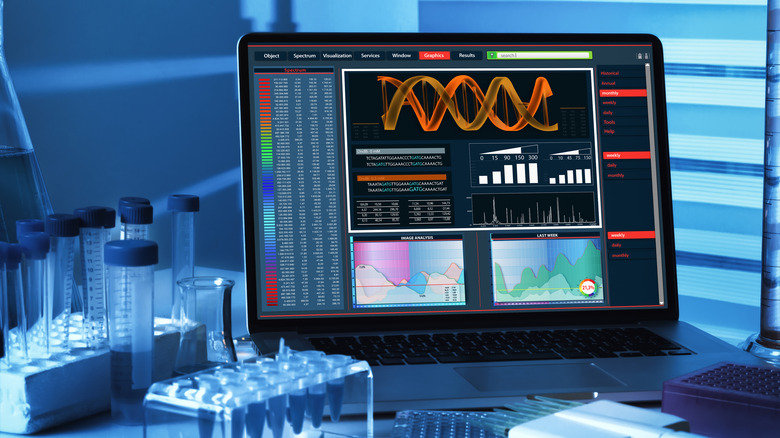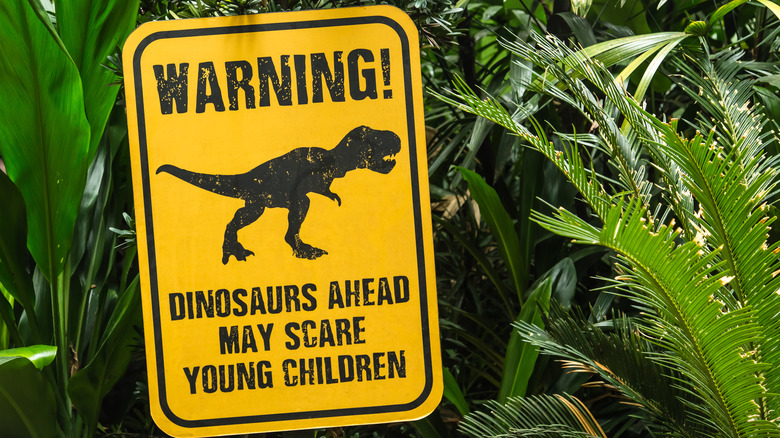Is It Really Possible To Clone Dinosaurs?
Everyone's seen "Jurassic Park," and yet for some reason everyone still thinks it would be kind of cool if scientists could bring back dinosaurs. Never mind that every installation of the "Jurassic Park" franchise so far has made it clear that bringing back dinosaurs would mean Tyrannosaurus rex in the city streets, Velociraptors on the subway, and "got eaten" surpassing heart disease as the leading cause of death in America.
But hey, maybe it's a good thing that people trust science enough to believe that those things wouldn't actually happen, that dinos would stay safe in their enclosures at the local zoo, and that maybe you could even have your own pet Velociraptor. If that's you, it might be disappointing to hear that it's unlikely you'll be seeing any live dinosaurs anytime soon. There are way too many technical hurdles in the way, not to mention the moral and ethical issues. So what's the deal? Why can't you just suck the DNA out of a 70-million-year-old mosquito and bring back T. rex? Because "science," that's why.
There's the small problem of decomposition
Every living thing dies, and then decomposes. Unless you're lucky enough to have a bunch of priests from ancient Egypt around to make you look presentable for your grand entrance into the afterlife, you're going to lose most of your good looks within the first two days after death. And, according to Mental Floss, your DNA starts breaking down almost immediately, along with all the other parts of you that go on to feed the worms and fertilize the flowers.
Even under perfect conditions, scientists don't think DNA is especially resilient. According to a 2021 study published in the journal Nature, the oldest DNA known to science is over 1 million years old, from mammoths recovered from Siberian permafrost. Now granted, that is very old by human standards, but consider this: DNA from the last dinosaur that ever lived would be another 65 million years older still, and that's an awful lot of years.
There were actually cold-climate dinosaurs (via Acta Palaeontologica Polonica), so in theory, it's possible that a few might have died in places where the conditions were just right for long-term preservation. Still, even if those dinos rested in peace in below-freezing temperatures, and the climate never changed, it would take just 6.8 million years for their DNA to turn to dust (via Mental Floss). Which means that if scientists wanted to sequence some of that DNA, they're just under 60 million years too late.
Modern cloning has been done with cells, not with DNA
Even if scientists did have a complete strand of dinosaur DNA, they don't actually have the technology to use DNA alone to re-create an animal. In order to create clones using modern technology, scientists need a living egg cell so they have something to put the DNA into (via National Geographic). The egg cell then has to be implanted into the uterus of a host mother, which ideally is a member of the same species as the clone. Not only do they not have any dinosaur egg cells, they also don't have any dinosaur mothers, and never mind that egg-laying species don't actually have an internal incubation chamber to implant the egg into (via Audubon).
So what scientists really need is to be able to go back in time, get a living dinosaur egg cell and some intact dino DNA, and then they'll have the raw materials needed to re-create a dinosaur. On the other hand, if they had the technology to go back in time and obtain a living dinosaur egg cell and some DNA, they really wouldn't need to re-create dinosaurs, because they could just kidnap entire baby dinosaurs instead.
Re-created dinosaurs wouldn't be exactly right
Scientists have been pondering the idea of "de-extinction" for many years, mostly for animals that became extinct because of some man-made injustice. Passenger pigeons, for example, became extinct because people ate them and annexed most of their habitat (via John James Audubon Center), and the quagga — a subspecies of plains zebra — was hunted to extinction by European settlers (via CNN). People who advocate bringing back these and other recently extinct creatures say success would right a terrible wrong.
Now, let's say there was a similarly compelling reason for bringing back the dinosaurs, such as how humans callously capitalized on their misfortune by evolving from tiny, burrowing mammals into world-dominating primates, which just seems not fair. Even so, scientists have to overcome a lot of hurdles to de-extinct even recently deceased animals, and these are animals they have mostly complete genomes for. There's always going to be some degradation of the DNA, for example, which means there will be guesswork involved, and the re-created animal won't be exactly like the original (via Genes). Also, some genes won't activate unless in the presence of certain environmental triggers. Let's say scientists were able to re-create a hadrosaur — without a prehistoric climate and a herd of other de-extinct hadrosaurs, the new animal won't have all the same traits that made a hadrosaur a hadrosaur. It might be sort of a hadrosaur, but if it isn't exactly like the original doesn't that defeat the purpose of trying to bring it back?
Their bird cousins are clone-proof
Science has had the ability to clone animals for a few decades now. In 1996, Dolly the sheep proved to the world that you don't always need both a sperm and an egg to make a baby. Since then, scientists have cloned a lot of other animals, including mice, pigs, horses, dogs, and cats (via LiveScience). Notably absent from this list, however, are birds. So far, science has not been able to figure out how to clone a bird, and that has larger implications for future plans to clone the egg-laying dinosaurs.
According to Audubon, some scientists don't think it's possible to clone birds at all. That's because currently the cloning process is fundamentally incompatible with the way birds reproduce. To clone a mammal, the nucleus of a living egg cell is removed and replaced with genetic material from the donor animal. When the new embryo is big enough, it's implanted into the uterus of the host parent, where it continues developing until it's ready to enter the world. In a bird's egg, the nucleus that contains the genetic material is a tiny spec located somewhere within the egg yolk, and because the yolk is too large to be observed under a microscope, it's so far proven impossible to isolate that tiny spec so the nucleus could be replaced with donor DNA. Also, because bird embryos incubate externally, you can't just implant the modified egg into a host parent and let nature take its course.
There's also the problem of the egg itself
Let's say scientists were able to find the little spec of a nucleus inside an egg yolk, replace it with new genetic material, and then somehow it was able to resume the normal developmental process of moving down the oviduct, receiving a hard shell coating, exiting the host parent, and then incubating for the correct amount of time under the host parent's watchful eye. Great, we've got a bird clone. But for dinosaurs, there's an extra problem — scientists have no way of knowing what the internal environment of that particular animal's egg was like 66 million years ago. In other words, we'd have to be able to precisely re-create the egg, as well as insert the genetic material into that egg (via Scientific American). Even if scientists had a fossilized example of an egg and understood its basic external structure, they still wouldn't know the exact composition of all the internal stuff that would be needed to nurture a baby dinosaur.
Given a miraculously preserved strand of DNA and the technology to clone a bird, scientists could maybe try using a cassowary egg to produce a Corythoraptor jacobsi, a dinosaur that looked an awful lot like a cassowary but went extinct 66 million years ago (via Science Alert). Even so, just because the two species look similar doesn't mean their eggs would be anything like each other, so it would likely be a very expensive and ultimately doomed experiment.
Scientists don't even know if the modern planet could support a resurrected dinosaur
The modern Earth is a very different place from the prehistoric Earth where dinosaurs thrived. According to LiveScience, it has a different climate, and dissimilar contents of carbon dioxide and oxygen in its atmosphere. The plants are all different, too — even the soil isn't the same. The truth is, scientists know precious little about all the variables that would be necessary to create the right environment to support our "Frankensteinian" creations. It's possible that our newly hatched dinosaurs would take a couple of breaths and die. If they could at least breathe the air, maybe they'd try browsing on some modern ferns and die a more prolonged death, because they lack the right digestive enzymes to get nutrients out of those modern plants — or because the plants are toxic to them.
This is a major problem when taking an animal out of its habitat and fast-forwarding it to the modern era. Birds, the closest living relatives of dinosaurs, have had 66 million years to evolve with and adapt to the planet as it is today. Resurrected dinosaurs aren't going to have that same evolutionary history, so it would be a bit like dropping a human being onto a completely different planet without a spacesuit. Sure, the planet might possess some of the elements necessary to sustain life, but a few important differences could be enough to make survival impossible.
Researchers tried to get DNA out of copal with no success
The idea that scientists could get DNA out of blood from a long-dead mosquito is intriguing, and even seemed pretty plausible for those of us who first witnessed the idea way back in 1993, with the release of the first "Jurassic Park" film. Scientists were intrigued too, and in fact, some of them actually tried it.
In 2013, scientists tried to retrieve DNA from a stingless bee entombed in 10,000-year-old copal, the sub-fossilized precursor of amber (what amber is before it becomes amber, via PLOS One). They were not only unable to find DNA in the 10,000-year-old specimen, they were also unable to retrieve anything useful from a similar specimen that was only around 60 years old. The younger sample did contain DNA, but it was more similar to the DNA of a bumblebee than that of the entombed stingless bee. The researchers noted that the DNA could have just been especially degraded, but either way, even 60-year-old DNA wasn't very well preserved in copal, which means the DNA inside an entombed mosquito would likely disappear long before the copal actually became a piece of amber.
The authors also noted that amber really isn't a great medium for preservation anyway because, even if there was some DNA in a piece of copal, the combination of heat and pressure that occurs over the years — as a piece of copal turns into a piece of amber — would probably destroy it.
DNA found in dinosaur bones might not actually come from dinosaurs
Still, there are those rare occasions when scientists have found dinosaur bones that look a lot, well, fresher than dinosaur bones are supposed to look. In 1997, a paper that appeared in the Journal of Vertebrate Paleontology claimed to have discovered fragments of collagen and hemoglobin molecules in the bone of a Tyrannosaurus rex. Not everyone was convinced, though. According to Discover, other scientists pooh-poohed the discovery, saying the material must have come from an outside contaminant. Undeterred, paleontologist Mary Schweitzer — the author of the 1997 study — suggested that if cellular material could be preserved for millions of years, there might be circumstances under which DNA could be preserved, too.
Then, in a 2020 paper published in National Science Review, Schweitzer and her co-authors reported finding the chemical markers of DNA in the calcified cartilage of a duck-billed dinosaur. And in 2021, researchers announced that they'd identified potential DNA molecules from a 125-million-year-old Caudipteryx (via Communications Biology).
Still, many scientists remain unconvinced, noting that it would be really easy for foreign DNA to infiltrate those samples. A dead animal, after all, decomposes in an environment filled with other organisms, and even millions of years after its death an exceptionally well-preserved bone is going to contain microbes, both living and dead. To an eager scientist, the DNA from those microbes could be mistaken for the DNA of the dinosaur from which the bone originally came.
You can't just fill in the genetic gaps
Even if you could find dinosaur DNA, it would likely be pretty fragmented and missing chunks. Michael Crichton knew this when he wrote "Jurassic Park," the novel that went on to become a blockbuster movie franchise. In the book, scientists sensibly use chicken and amphibian genes to fill in the gaps, but in the movie, it's just frog DNA — which was a dumb decision.
When "Jurassic Park" was released in 1993, scientists were already aware that birds were dinosaurs' closest living relatives, so the idea that Hollywood's fictional geneticists chose to re-create the "Jurassic Park" dinos with DNA from frogs — instead of, say, cassowaries — is absurd. To be fair, the writers did not yet know that condors can reproduce asexually (via CNN), so they kind of needed the frog DNA in order to make the leap to that cringe-worthy "life finds a way" plot twist.
Anyway, the "fill in the gaps" solution lacks merit for other reasons, too. According to the Natural History Museum of London, scientists would need to already possess the entire genome in order to even know what to put in the gaps. Without it, the process would be akin to throwing a bunch of random letters into a can of alphabet soup, and then expecting it to land in your bowl as a complete sonnet. In other words, without the complete genome, you aren't going to have any idea of how to re-create that animal.
Bringing back dinosaurs could cause another pandemic
When most people think about the dangers of bringing back the dinosaurs, they consider the fact that the majority of humans don't want to be hunted by very, very large predators — but bringing back a creature that lived millions of years ago also holds less obvious dangers. First of all, even if scientists could find an ecosystem that was capable of supporting these newly resurrected creatures, they would qualify as invasive species, which means they might disrupt and even destroy any present-day ecosystem they were placed in. Given that planet Earth is already losing ecosystems at an unprecedented rate, maybe purposely creating new invaders wouldn't be such a great idea.
What if scientists brought back a peaceful, herbivorous sort, that they could just put in a glass dome with some tropical plants and watch while it grazes happily through its weird life, oblivious to the fact that its closest living relative died millions of years ago? Sounds safe enough. But LiveScience notes another small problem — DNA contains a lot of junk. Furthermore, some of that junk may be inherited viral DNA that, generations before, was just kind of hanging around in a cell after infection and ended up being incorporated into the animal's genome (via Britannica). What if resurrecting the dinosaur meant awakening a prehistoric virus, with the ability to infect modern humans? That could be a lot worse than an escaped T. rex and a couple of Velociraptors.
Reverse engineering a dinosaur-like creature might be easier
What if you could take a modern creature and reverse engineer it to look like an ancient one? The science behind this idea is pretty sound, at least for recently extinct animals. The idea behind this is that certain genes that were expressed in an extinct species are probably still present, but "switched off," in its close living relatives. Scientists have, in a way, resurrected the extinct quagga with this approach (via CNN), by selectively breeding for the quagga's distinctive coloring in plains zebras. These animals aren't exactly quaggas, since the original species almost certainly possessed other traits scientists don't even know about, but close.
It's one thing to do this with closely related species, but quite another to do it with a dinosaur. Still, some scientists are trying, including Jack Horner, famous for the "Dino-Chicken" project that was much talked about circa 2014, for a while at least. Since then, researchers in Chile were able to manipulate chicken genes to produce chickens with dinosaur-like legs (via Evolution), while Harvard and Yale researchers were similarly able to put a dinosaur-like snout on chicken embryos (also via Evolution). So in theory, you could reverse engineer a dinosaur-like chicken in this manner, but to what end? A lovely little freak show, perhaps, but creating a creature that nature never intended does beg an awful lot of moral and ethical questions.
Synthetic DNA may be a potential solution
Retrieving viable ancient DNA is seemingly impossible, and let's just admit that a world populated by "dino-chickens" is not very appealing. But what if scientists could just artificially re-create DNA instead? What if scientists were somehow able to figure out what a dinosaur's complete genome looked like — could they just make it in a lab?
Maybe, in theory at least, though not having a preserved strand of DNA to use as a reference is still a pretty big hurdle to overcome. But let's say a researcher found one of God's dinosaur templates, written in microscopic font, tucked away in the Vatican or some such hypothetical scenario. Well, using that information to physically synthesize an entire DNA sequence would still be a monumental task. In 2017, scientists were able to do this with a 770 kilobase DNA sequence — a strand containing 770,000 base pairs of DNA (via Genes). The creature in question: some yeast. So, not an especially complex animal, and larger animals have many, many more base pairs — hundreds of millions of them, which means it's not possible to synthesize the DNA sequence for an entire, large dinosaur with the technology that exists today.
But, technology is improving, so maybe there's hope. Maybe one day scientists will know enough about genomes to be able to make educated guesses about what a dinosaur's genome probably looked like. And maybe, one day, scientists will also be able to invent a computer that doesn't crash. Anything's possible.
Is it really a good idea anyway?
Let's say all the hurdles were overcome, and scientists figure out exactly how to re-create a dinosaur. They have the genome, they have an artificial egg, they've got a climate "bubble" that replicates the exact conditions that dinosaurs once lived in, and all they need is some funding from the "University of Questionable Ethics." Then what? Would the synthesized animal that came out of that artificial egg actually be a dinosaur?
Maybe not. Such a creature would have no ties to the world it was dropped into, no genetic history, and no friends or relatives. At best, it would become a dinosaur-like zoo exhibit, at worst, a lonely thing living in a world that it doesn't belong to. According to Paleontology World, putting an extinct animal back into an unfamiliar world would be cruel, not just because the plants and temperatures are all wrong, but because the world has been emptied of the species it evolved amongst and interacted with. "Because it's cool" isn't really a great reason to subject an animal to that kind of existence.
And anyway, you can look at it rationally — there are already dinosaurs living among us. Why resurrect a Corythoraptor jacobsi when the cassowary already looks almost exactly like it, and is also endangered? Maybe science should focus on saving the species that are here now, instead of trying to bring back animals not meant to be here at all.
